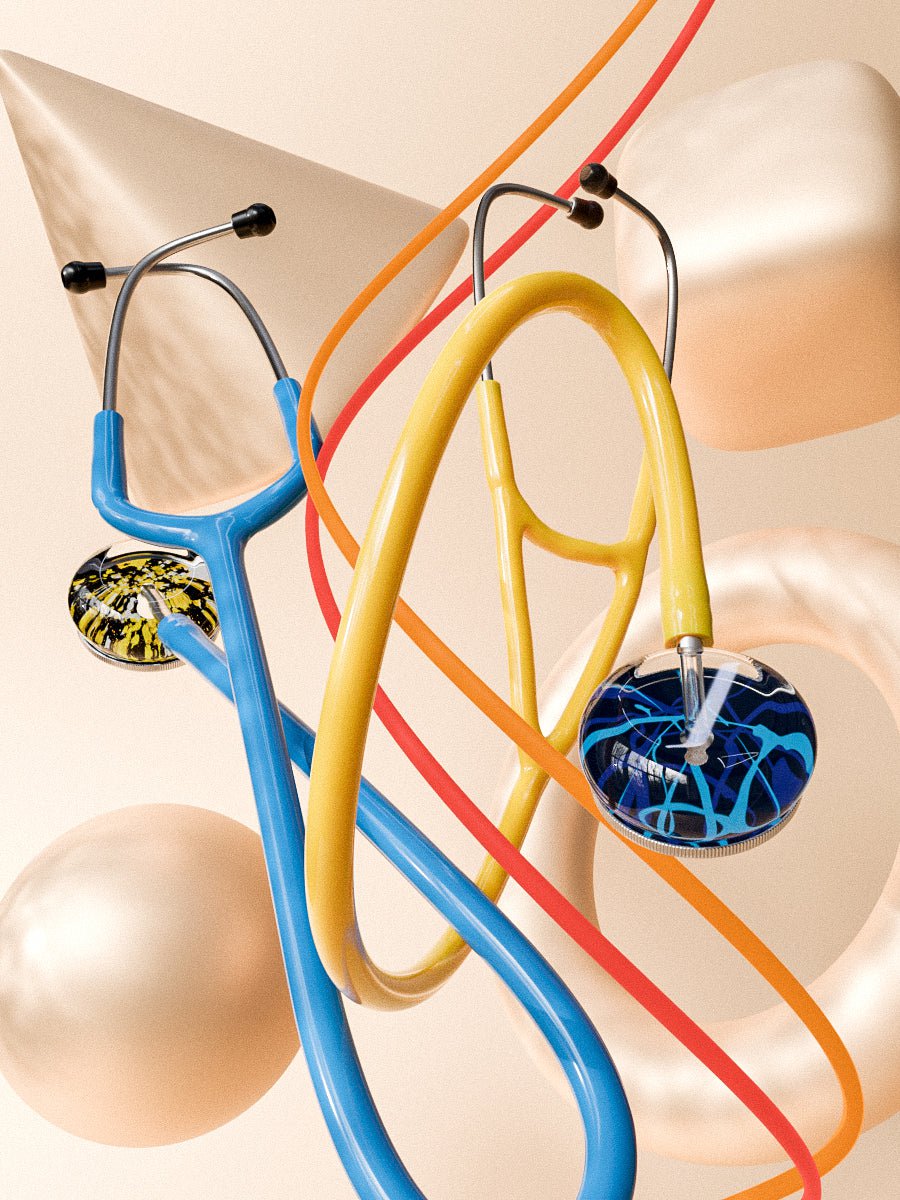The stethoscope is one of the most used pieces of medical equipment. It is used by multiple types of medical professionals: doctors, nurses, respiratory therapists, emergency medical technicians (EMT), veterinarians, to name but a few. It is used to listen to the sounds inside the body of humans, and animals, and although it magnifies the sound, it may not be magnifying enough, if you suffer from hearing loss.
If you are in the medical profession and have a loss of hearing, you may be considering hearing aids, or maybe you have already been fitted with a set. Whether you already wear them or plan to, you might be asking, "can I wear my hearing aids while using my stethoscope?" The answer is, yes. In this article, you will find more information about hearing aids and stethoscopes. You can find information on stethoscopes for hearing impaired here.
The stethoscope
The stethoscope is critical for being able to discern issues with the heart, the lungs, and the abdomen. It is one of the first pieces of equipment to be used in an exam. Medical professions rely on what they hear through it, to be able to get the vital information they need for diagnostic purposes.
The stethoscope is designed to amplify the low-tone sounds found in the body, from the heart rate and blood flow sounds, digestive and bowel sounds, and the low-tones of breathing and air exchange. If you wear a hearing aid, it is important to make sure they work with the stethoscope so that you can hear all the correct inner body sounds and block out the sounds being picked up in the background by the mic of the hearing aid.
Types of hearing loss
There are three different types of hearing loss: sensorineural, conductive, and a combination of both. Sensorineural occurs when there is a problem with either the inner ear or with the auditory nerve, and subsequently, sounds cannot reach the brain. Conductive hearing loss happens when sound cannot reach the inner ear, and subsequently, sounds cannot reach the brain. Conductive hearing loss most often occurs due to an obstruction or injury. And lastly, combination hearing loss is simply a combination of the two.
Depending on the type of hearing loss, you could experience a variety of hearing loss symptoms. Most commonly, people with a loss of hearing will lose the ability to hear either low-frequency sounds or high-frequency sounds, or both in some cases. The loss can range from mild to severe. If you ignore your hearing loss, you may find it becomes more difficult to hear sounds through a stethoscope.
If it is severe enough, you may be considering a hearing aid, but can you wear your hearing aids while using your stethoscope? There are plenty of options for those who are required to use a stethoscope as part of their job, including, a variety of hearing aids.
Types of hearing aids
There are hundreds of different types and styles of hearing aids. As mentioned, the degree of loss of hearing will play a role in which types of aids will work best for you. But you should consider all the styles, along with the hearing aid circuitry when discussing them with your doctor. They can help you find the best aid for you and your career. Here are some examples of the hearing aids available.
- In the ear (ITE)
- Completely in the ear (CIC)
- Behind the ear (BTE)
- Receiver in the canal (RIC)
- In the canal (ITC)
- (ITC) models
- Invisible (IIC)
Many of these hearing aids fit into the ear and block the entire inside of the ear, leaving no room for the tips of the stethoscope. Others block just the canal. Although the tips of the stethoscope can fit in the ear, the sounds may not be as clear coming through, not to mention, the microphones of the hearing aids are still able to pick up other sounds and noises in the room, which can be distracting in hearing the sounds you should be hearing in the body.
Wearing hearing aids while using a stethoscope
Removing hearing aids to use the stethoscope is not an easy option for most, especially in fast-paced medical settings when you need to use your stethoscope quickly and often. Removing hearing aids is cumbersome and annoying. For most medical professions, this is not an option.
Most people with hearing loss retain the ability to hear lower-frequency tones, as opposed to the higher frequency. This form of hearing loss is more conducive for working with a stethoscope because stethoscopes pick up low tones. This means you will still be able to hear these tones without issues.
The ability to hear low tones may give you the option to use certain types of hearing aids with your stethoscope, including, the open-fit hearing aid, which might be a great option for you. Open-fit aids leave the ear canal open, which allows for the lower-tone sounds to flow into the canal naturally.
Hearing aids that fit behind the ear, or the receiver is in the canal, are the easiest hearing aids for wearing with stethoscopes. Behind the ear hearing aids leave the canal open and free for putting the tips of the stethoscope in. But you may pick up outside noises from the mic, that may be distracting to your auscultation process.
In the ear canal type hearing aids are another hearing aid that can be classified as stethoscope friendly. The hearing aid fits at the top of the ear and only the receiver fits into the canal. When using the stethoscope, you can pull the receiver out and put the stethoscope tips in, while using it. The receivers are easy to put back into the canal once the exam is over.
Some in-the-canal hearing aids can be worn while using a stethoscope, but they would need to be the type that fits deeper in the canal so that the tips of the stethoscope can fit comfortably in the canal. These types of hearing aids may need to have the receiver turned off while using the stethoscope, then turned back on when you are done. Keep in mind, this can be a bit of a headache if you must flip it on and off often.
Special stethoscopes
If your hearing aids are not able to work with a stethoscope, another option is to consider special stethoscopes that amplify the sounds better, for those with hearing loss. You can find a variety of different types of stethoscopes that are geared for those with a form of hearing loss, online and through different medical supply companies.
The important thing is to talk to your audiologist to find out what your best options are for your hearing issues and having to use a stethoscope for your job.





